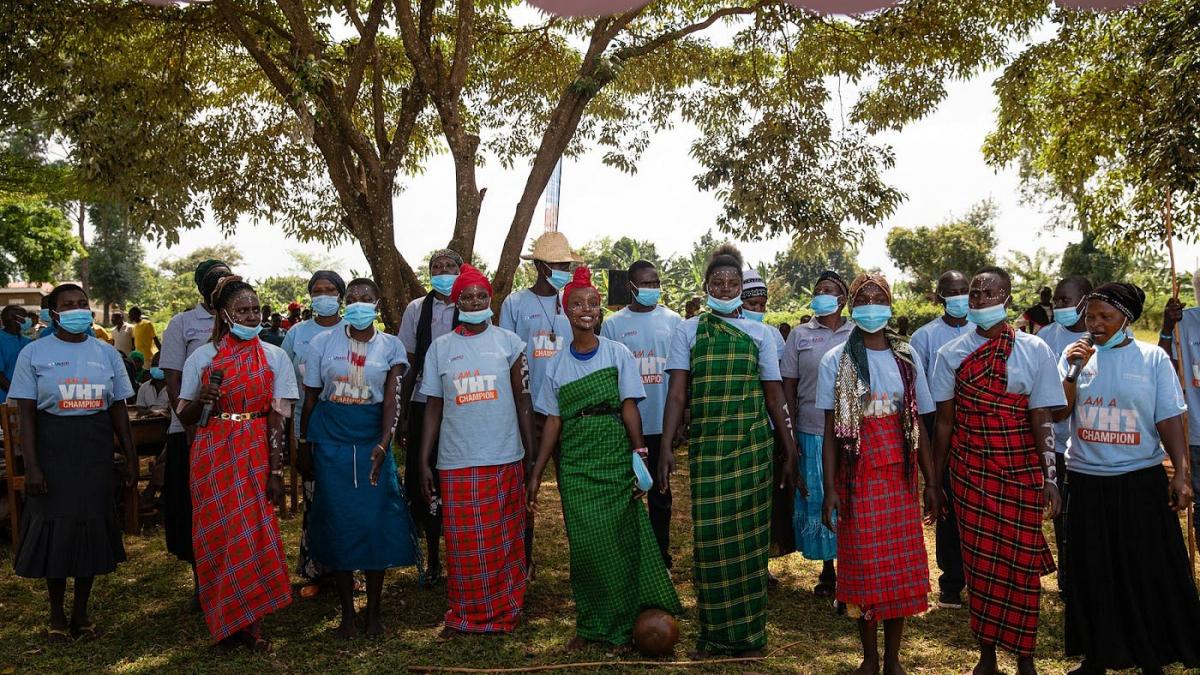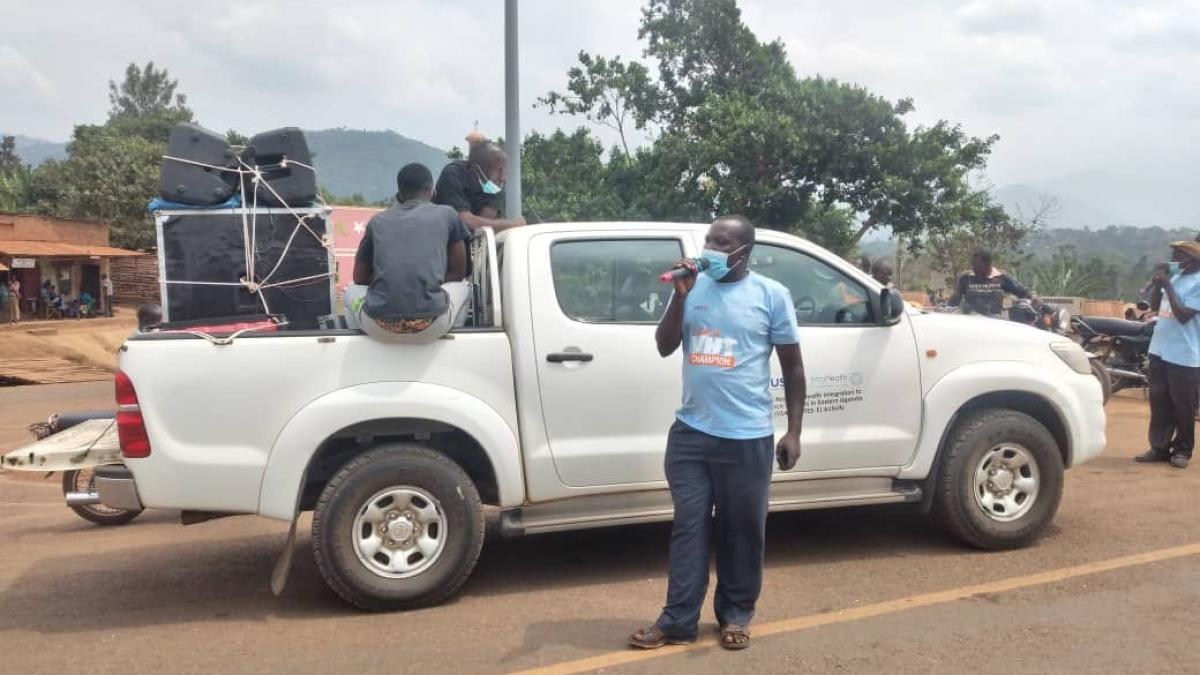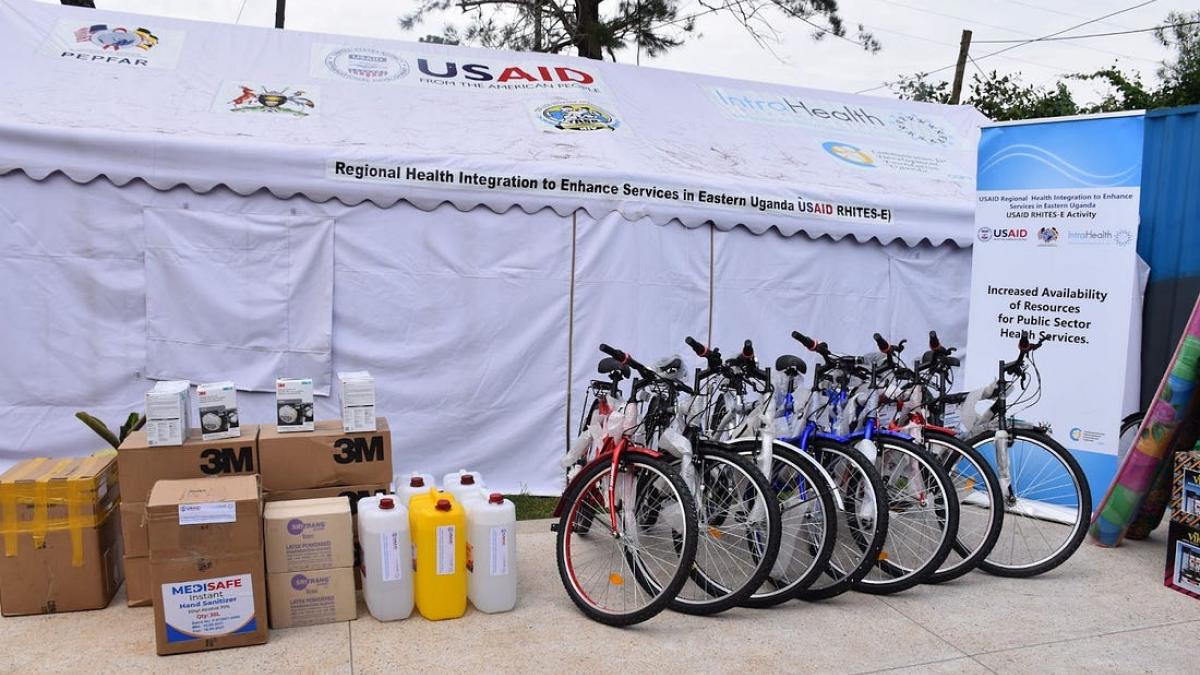It Takes a Village! How Adults in a Hard-to-Reach District in Uganda Embraced the COVID-19 Vaccine
With USAID support, Bududa District overcame varied challenges and vaccinated most of its adult population
Some of the health care workers who received training on COVID-19 vaccine management and risk communication in the Eastern region ready to serve. / Irene Mirembe, Intrahealth
Addressing the COVID-19 pandemic seemed an impossible task, given that many Ugandans have long experienced vaccine hesitancy and have limited access to reliable health care.
As most of Uganda’s regions struggled to get their residents vaccinated against COVID-19, the Bududa District had a different story: Over 90% of its adult population was fully vaccinated.
Bududa is a hard-to-reach, landslide-prone area with rugged terrain on the slopes of a mountain along the Uganda-Kenya border. The estimated 270,000 people living there have long experienced poor health outcomes, including a high maternal mortality rate and increasing malnutrition cases. Many feared COVID-19 would further exacerbate the already challenged district which suffers from unreliable road access, poor health outcomes, and a struggling health system.
District leadership worked with USAID’s Regional Health Integration to Enhance Services in Eastern Uganda Activity and its partners to design and implement a comprehensive COVID-19 vaccination strategy. And the strategy worked in a big way. By the end of 2022, most of its adults–around half the population in Bududa District–had been fully vaccinated against COVID-19.
USAID learned lessons from Bududa’s success, including four strategies to consider for the future.
1. Deploying evidence-based planning and quick decision-making
Knowing the difficulty in traveling the district — including limited resources, poor road networks, and a highly mobile population — the district health team quickly chose the Johnson and Johnson one-jab vaccine. The district established a COVID-19 response team comprising the health team, administration officers, and political, cultural, and religious leaders to coordinate partners and mobilize resources and communities for vaccine uptake. The health team engaged sub-district and sub-county teams while also working on efforts to reach everyone old enough to receive the vaccine.
“Being a hard-to-reach district with many porous borders made the pandemic [seem] uncontainable. We had to find solutions quickly and avoid further spread,” said Dr. Imelda Tumuhairwe, the district health officer in Bududa District.

A group of Village Health Team members shares information about COVID-19 vaccination through drama at a vaccination point in the community in Eastern Uganda.
Irene Mirembe, Intrahealth
2. Creating demand
To increase people’s interest in and comfort with the vaccine, the district COVID-19 response team produced radio talk shows, sharing information that addressed common myths and misconceptions. The team also publicized vaccinations of influential government officers and local political and religious leaders. This allayed fears and sparked interest.
“Initially, it was difficult because of disinformation from social media,” said Dr. Enid Ntegeka, the medical superintendent at Bududa Hospital. “The District Health Office mobilized the top district officials and health workers. We started the drive with the public witnessing that we were the first people to get the vaccine. Confidence was built, and after that, we used all the avenues to mobilize the public to increase vaccine demand and uptake.”

A Village Health Team member encourages people to go for COVID-19 vaccination through a community drive in Eastern Uganda.
Irene Mirembe, Intrahealth
3. Creating a network of vaccination teams
To respond promptly to demand, the district health unit established two types of teams to deliver vaccines effectively. An advance team comprised the village health workers, volunteers, and sub-county leaders who helped identify residents and provided vaccination appointments. A second team comprising a nurse, a health information assistant, a community health worker, and a health assistant administered the vaccines. A total of 96 vaccination teams meant that the whole district was covered, and vaccines were delivered where they were most needed.
Health center workers were asked to establish their patients’ COVID-19 vaccination status during routine care and directed clients to a nearby vaccination site. The teams identified effective opportunities and locations for vaccination, including busy trading centers, markets, schools, and religious and political gatherings.
USAID’s partner, IntraHealth, trained 180 members of the vaccination teams on COVID-19 risk communication and vaccine storage and management so they could deliver the best possible service.

Equipment provided by the RHITES-E team to support distribution of COVID-19 vaccines in the Eastern region.
Irene Mirembe, Intrahealth
4. Using real-time data and communication platforms for effective coordination
The district health office established a dedicated WhatsApp group for health facilities and the vaccination teams to share daily vaccination updates. The phone-based messaging app is popular in Uganda. Team and health facility leaders used another WhatsApp group to share information and discuss challenges. This rapid information exchange meant it was possible to provide quick practical solutions, course correct, and redistribute vaccines to avoid wastage.
The district is now strengthening its systems to prepare, detect, and respond to other disease outbreaks. This is especially important in light of other potential outbreaks, such as anthrax and Ebola.
Using the lessons learned in Bududa and elsewhere, USAID and its partners are supporting a plan for integrating COVID-19 vaccination into routine health care. With this, more people are protected and avoidable health burdens do not further strain the under-resourced health system.
About the Authors
Irene Mirembe is the Knowledge Management Manager for the USAID Regional Health Integration to Enhance Services in Eastern Uganda Activity. Jennifer Tumusiime is the COVID-19 Knowledge Management Specialist with USAID’s Uganda Learning Activity.

